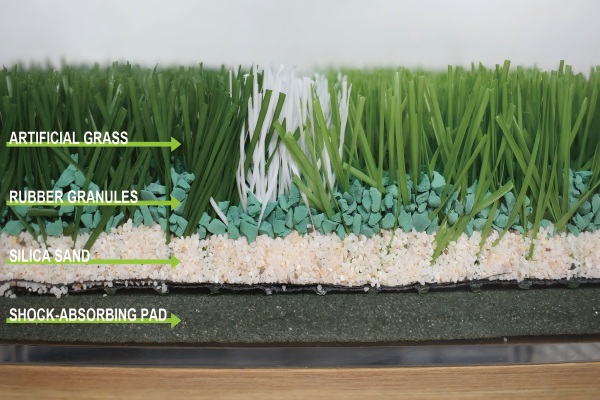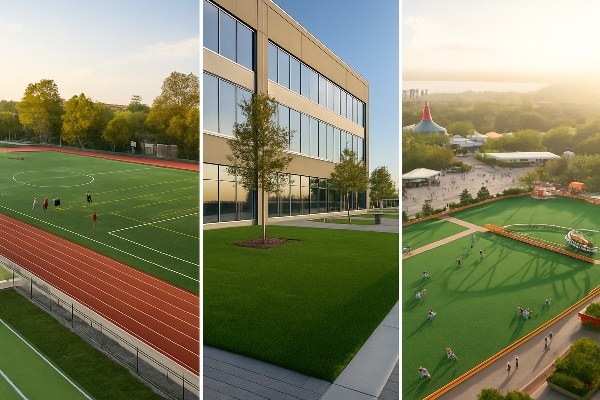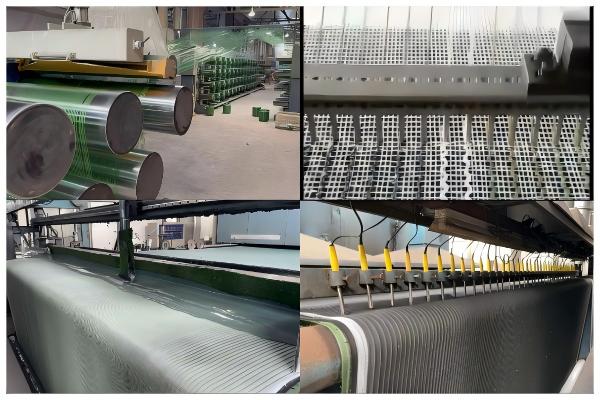Unsure about artificial grass quality? Choosing the wrong material can lead to costly failures. Understanding what it’s made of helps you purchase smart and protect your profits.
Artificial grass is primarily made from plastic polymers. The blades, or yarn, are usually polyethylene (PE) or polypropylene (PP). The backing consists of fabric layers and a latex (SBR) or polyurethane (PU) coating. These materials combine to create a durable, realistic-looking surface.

So, the basic recipe is plastic yarn, a fabric backing, and a glue coating. But this simple description hides a lot of important details. The specific type of plastic, the structure of the backing, and the manufacturing process all have a huge impact on the final product’s performance and cost. To really understand what you’re buying, we need to break it down piece by piece. Let’s start with the specific ingredients.
What are the ingredients in artificial grass?
Confused by technical terms like PE, PP, and SBR on spec sheets? This confusion can lead to buying the wrong product. I’ll break down each ingredient for you.
The main ingredients are polyethylene (PE) or polypropylene (PP) for the yarns, often with UV inhibitors and color masterbatch. The backing is made of polypropylene cloth and mesh, bonded together with a Styrene-Butadiene Rubber (SBR) or Polyurethane (PU) coating for stability and durability.

Understanding the materials is crucial. In my early days in the factory, I learned that small changes in these ‘ingredients’ can make a massive difference in quality and longevity. Let’s look closer at each component.
The Yarn (or Blades)
The yarn is the part you see and feel. For most landscaping and sports applications, it’s made from polyethylene (PE). PE is popular because it offers a great balance of softness and resilience. Another material is polypropylene (PP), which is stiffer and more abrasive. Because of this, PP is often used for sand-filled putting greens or as a curly secondary "thatch" yarn to provide support for the main PE blades. For high-end sports fields, some products use Nylon. It is extremely durable and heat-resistant, but it’s also much more expensive. We also add masterbatch for color and UV inhibitors to prevent the grass from fading in the sun.
The Backing System
The backing is the foundation that holds everything together. It’s usually a two-part system. The primary backing consists of a woven polypropylene cloth that the yarns are tufted into. This is then bonded to a secondary backing, which can be a mesh fabric or another non-woven cloth. This layered combination provides dimensional stability, which stops the turf from stretching or shrinking with temperature changes. A weak backing is a common point of failure I’ve seen in low-cost products.
The Coating
The coating is the ‘glue’ that locks the yarn tufts into the backing. The most common and cost-effective option is Styrene-Butadiene Rubber (SBR) latex. It’s effective for most applications. However, a polyurethane (PU) coating provides a significantly stronger bond and has better water resistance. I often recommend PU for premium installations, commercial projects, or in very wet climates because it ensures the fibers stay put.
Here is a quick comparison:
| Component | Standard Material | Premium Material | Key Characteristic |
|---|---|---|---|
| Main Yarn | Polyethylene (PE) | Nylon (Polyamide) | Softness vs. Extreme Durability |
| Thatch Yarn | Polypropylene (PP) | Polyethylene (PE) | Stiffness vs. Softness |
| Coating | SBR Latex | Polyurethane (PU) | Good Adhesion vs. Superior Bond |
What are the categories of artificial grass?
Do all artificial grass types look the same to you? Using the wrong type for a project can cause big problems and lead to unhappy customers. I will outline the main categories for you.
Artificial grass is broadly divided into three categories based on its use: Landscaping grass1 for gardens and decoration, Sports turf2 for fields like football and tennis, and Playground grass3, which is designed with extra safety and durability features for children’s play areas.

Choosing the right category is perhaps the most important decision you will make as a buyer. I once had a client in Australia who wanted to use a beautiful, soft landscape grass for a small community football pitch to save money. I had to explain that it wouldn’t last six months. The construction of sports turf is completely different from landscape grass, and using the wrong one is a recipe for failure.
Landscaping & Decorative Grass
This is the most common type you see in backyards, commercial areas, and on balconies. The main focus here is on aesthetics. The goal is to make it look and feel as much like real grass as possible. It often has multiple yarn colors, a brown or green thatch layer, and a softer feel. Durability is still important, but it is not designed for the intense, concentrated wear and tear of sports. The pile height usually ranges from 25mm to 50mm.
Sports Turf
This is a highly technical product. Whether it’s for football, hockey, or tennis, the priorities are performance, player safety, and extreme durability. The yarns are incredibly resilient, often featuring unique shapes (like Spine, Diamond, or C-shapes) to help them stand back up after being stepped on. These products almost always require sand and rubber infill. The infill supports the fibers, provides cushioning for players, and ensures a consistent ball performance.
Playground Grass
This category is a hybrid. It needs to be durable like sports turf but also soft and non-abrasive for children’s safety. It is often paired with a shock-absorbing foam pad underneath the turf. This foam layer is crucial to meet critical fall height requirements and prevent injuries. The yarns are typically soft PE, and the stitch rate is high to create a dense, lush surface that can withstand constant play.
How is synthetic grass made?
You know the materials, but how do they all come together to become a roll of turf? This knowledge gap can hide potential quality issues. I will guide you through the factory manufacturing process.
Synthetic grass is made in four main steps. First, plastic pellets are melted and extruded into yarn. Second, this yarn is tufted into a backing fabric, similar to a carpet machine. Third, a coating is applied to the back to lock the yarns in place. Finally, the finished turf is cured, inspected, and rolled.

I spent years in the factory technical department, so this process is very familiar to me. Every step is a potential point for quality failure, which is why strict oversight is so important for buyers like you. Here is a simplified breakdown.
Step 1: Yarn Extrusion
This is where we create the grass blades. We start with raw plastic pellets—PE or PP—and mix them with color masterbatch and UV inhibitors. This mixture is melted down into a liquid and forced through a steel plate with small holes, a process called extrusion. This forms long, continuous strands of yarn. These strands are then stretched, cooled in water, and wound onto large spools. The shape of the holes in the extrusion plate determines the cross-sectional shape of the yarn blade.
Step 2: Tufting
The large spools of yarn are then loaded onto a massive tufting machine. The machine works like a giant sewing machine, with hundreds of needles that punch the yarn into the primary backing fabric. As the needles punch through, a small looper holds the yarn, and then a blade cuts the loops to create the individual grass blades at a specific pile height. This process determines the density and height of the turf.
Step 3: Coating
At this stage, the yarn is only loosely held in the backing. The huge sheet of tufted grass is then sent to the coating line. It is flipped over, and a liquid layer of SBR latex or PU adhesive is applied to the entire back surface. This coating is what permanently locks the fibers in place. This is a critical step for durability; poor or uneven coating will result in a weak tuft lock, meaning the fibers can be pulled out easily.
Step 4: Curing & Finishing
The coated turf then passes through a long drying oven to cure the SBR or PU adhesive. After it exits the oven and cools, drainage holes are punched into the turf. Finally, the grass is trimmed to its final width, carefully inspected for any defects, and then rolled into large rolls for packaging and shipping.
Conclusion
Understanding that artificial grass is a system of yarn, backing, and coating allows you to ask the right questions and ensure you get the quality product your project deserves.
_画板-1.png)
_画板-1.png)